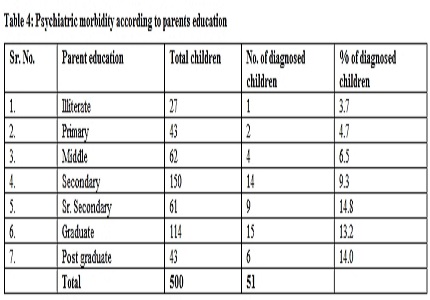Psychiatric morbidity in school going children of Bikaner
Abstract
Background: Psychiatry morbidity is a reality in our present day society. Its measurement requires a proper, standardized, screening tool and an extensively researched classification of psychiatric ailments. This study aims to determine prevalence of psychiatric disorders and pattern of psychiatric disorders, associated socio demographic variables in school going children.
Methods: The study was undertaken during 2004-2005. The sample of 500 children was drawn from children in the age group of 4-11 years from schools of Bikaner. All children in the selected sample were subjected to a screening for psychiatric symptoms by interviewing the parents of the children using childhood psychopathology score (CPMS). A score of 10 or above indicates the possibility of psychiatric morbidity among Indian children. All collected data were tabulated and statically analyzed.
Results: prevalence of psychiatric disorders in children was found to be 10.2%. conduct disorder was most common psychiatric disorder observed (31.4%) followed by anxiety disorders (21.6%).prevalence was more in children of male sex, nuclear families, higher birth orders and higher educated parents.
Conclusion: epidemiological studies should start early in childhood and carried longitudinally for development of preventive, promotive and curative programme in the community.
Downloads
References
2. Verghese A, Beig A. Psychiatric disturbance in children--an epidemiological study. Indian J Med Res. 1974 Oct;62(10):1538-42. [PubMed]
3. Deivasigamani TR. Psychiatric morbidity in primary school children an epidemiological study. Indian J Psychiatry. 1990 Jul;32(3):235-40. [PubMed]
4. Malhotra S. Study of Psychological determinants of Developemental psychopathology in school children- Report submitted to the Indian Council for Medical Research, New Delhi, 1995. [PubMed]
5. Achenbach TM, Edelbrock CS. Manual for Child Behaviour Checklist and Revised Child Behaviour Profile. Burlington,VT: University of Vermont, Department of psychiatry.1983.
6. Achenbach, TM., Manual for Child Behaviour Checklist/ 4-18 and 1991 profile, University of Vermint, Burlington. 1991:1-6.
7. The ICD-10 Classification of Mental and Behavioural Disorders: Clinical Description and Diagnostic guidelines. World Health Organisation.1992:225-291.
8. Roberts RE, Attkinson CC, Ftosenblatt A. Prevalence of psychopathology among children and adolescents. American Journal of psychiatry. 1998;131: 523-527.
9. Almqvist F, Puura K, Kumpulainen K, Tuompo-Johansson E, Henttonen I, Huikko E, Linna S, Ikäheimo K, Aronen E, Katainen S, Piha J, Moilanen I, Räsänen E,Tamminen T. Psychiatric disorders in 8-9-year-old children based on a diagnostic interview with the parents. Eur Child Adolesc Psychiatry. 1999;8 Suppl 4:17-28.
10.Ghubash R, Abou-Saleh MT. Postpartum psychiatric illness in Arab culture: prevalence and psychosocial correlates. Br J Psychiatry. 1997 Jul;171:65-8. [PubMed]
11. Ollendik TH, Neville J. King PM. Fears and Phobias in children: Phenomenology, Epidemiology, and Etiology. Child and Adolescent Mental Health. 2002 Sep;7(3): 98-106. [PubMed]

Copyright (c) 2015 Author (s). Published by Siddharth Health Research and Social Welfare Society

This work is licensed under a Creative Commons Attribution 4.0 International License.


 OAI - Open Archives Initiative
OAI - Open Archives Initiative


